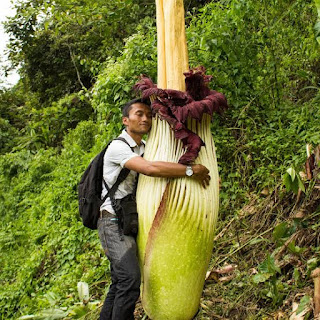It IS SAID THAT ,The “Corpse Flower” is not actually a single flower but an inflorescence (a stalk of many flowers). The flowers are a mixture of tiny male and female flowers held out of sight at the base of the central phallus-like structure (spadix) surrounded by a pleated skirt-like covering (spathe) that is bright green on the outside and deep maroon inside when opened. The female flowers mature before the male (pollen-producing) flowers which avoids self-pollination.
The plant typically requires at least 7 years before it blooms but it may take even longer.Ever since this plant was first identified in Sumatra, Indonesia in 1878 by Italian botanist Odoardo Beccari, it has excited worldwide attention due to its massive size, fascinating appearance, and habit of producing a foul odor resembling rotten flesh (to attract insects that pollinate it).
The corpse flower (Amorphophallus titanum) is listed as ENDANGERED BYIUCN, with an estimation of fewer than 1,000 individuals remaining in the wild. IUCN estimates the population has declined more than 50% over the past 150 years. The main reasons for the decline are logging and the conversion of the plant's native forest habitat to oil palm plantations.












